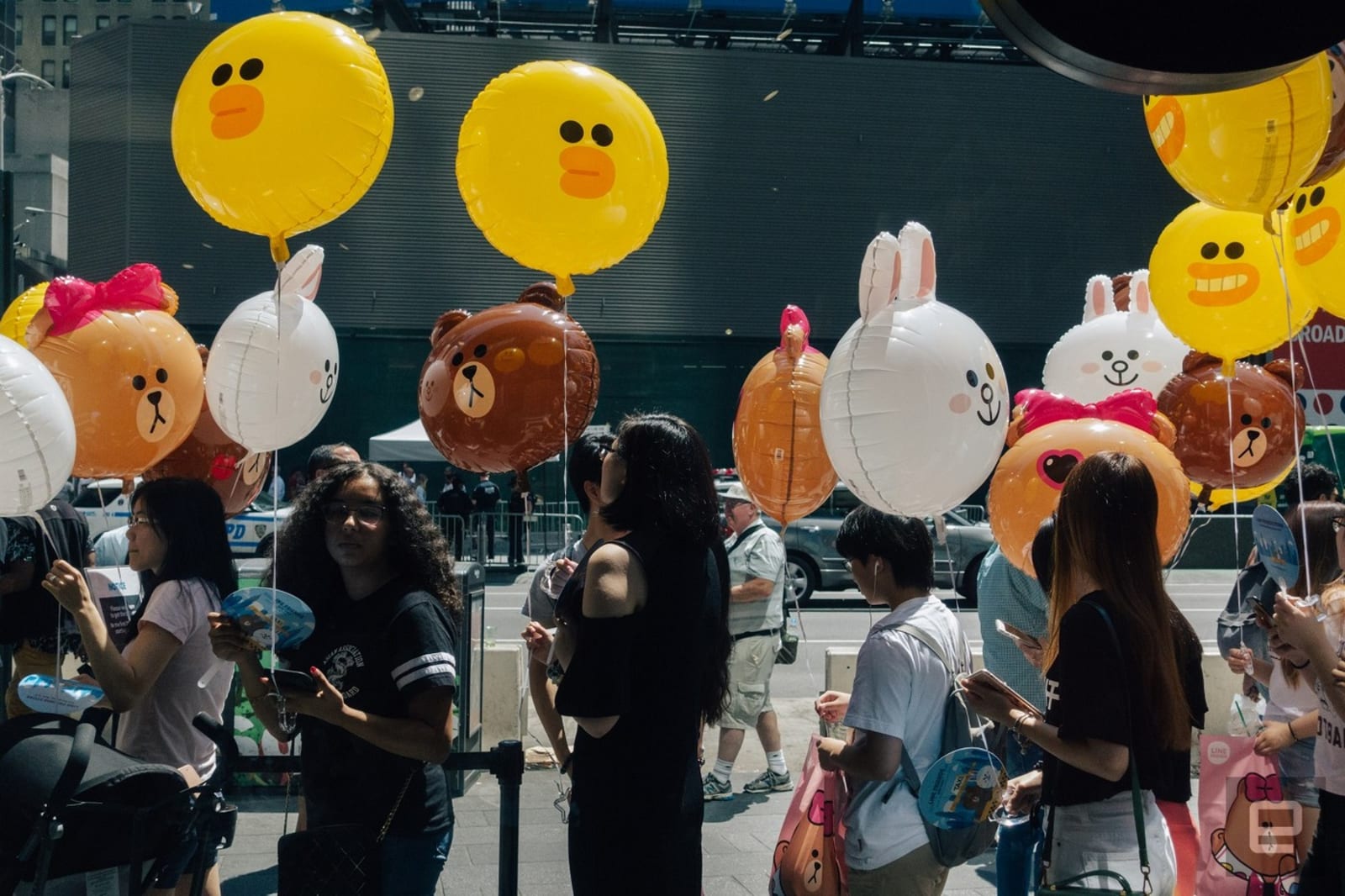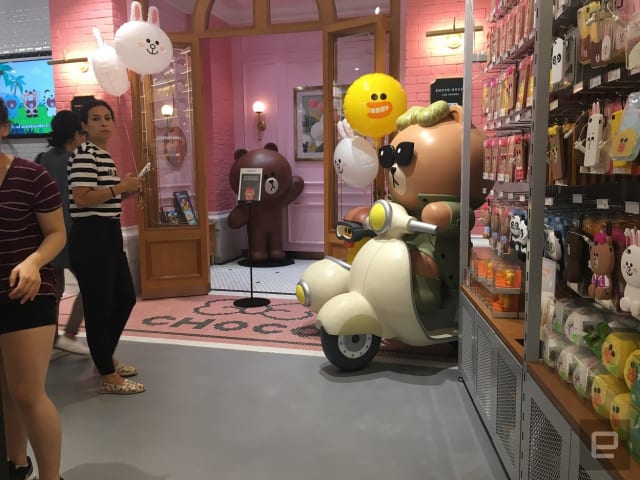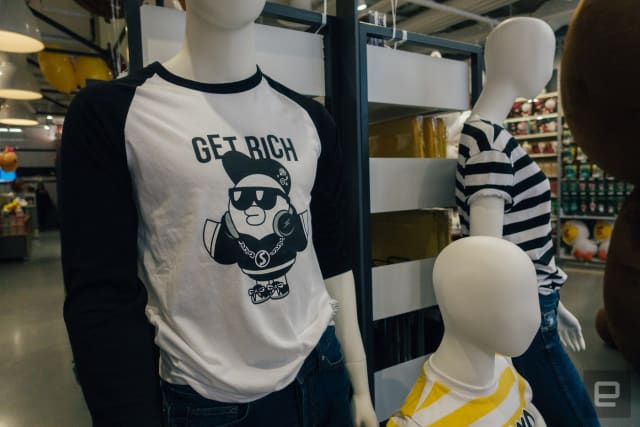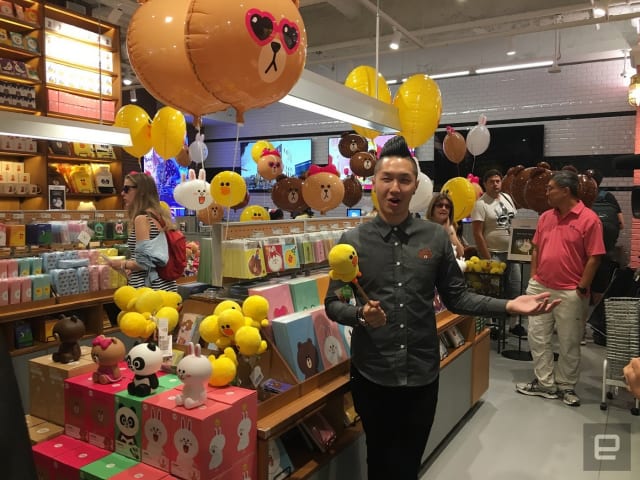[ad_1]
Line Friend’s CEO James Kim was on hand for the public launch of the first American store. Like those other outposts, the Times Square location’s walls are lined with apparel and stuffed versions of the characters. Brown the bear, chief among the brand’s mascots, appears most often, with a colossal 10-foot-tall incarnation greeting visitors at the front entrance. On the official opening day, two people clad in human-size Line Friends costumes met fans of the characters, which are otherwise pretty obscure here in the US.

The story of Line Friends begins with the March 2011 Tōhoku earthquake, which crippled cellular communications in Japan. To fill the gap, engineers from Naver Corp.’s subsidiary NHN Japan built their own internal chat tool. That June, they released it to the public as the Line smartphone app. Even then, Line found itself competing with WeChat, the messaging app from Chinese internet titan Tencent. To set itself apart, Line went after younger users with stickers — oversize emoji, really — including two free sets with a quartet of animal and human characters. Their cutesy appearance and comical antics endeared them to Line users. They have also sold really, really well: Stickers drew in $268 million for the company in 2016.
The stickers were the tipping point: After extensive focus group testing, Line chose characters that resonated with teenage girls, the tastemakers of Japan. The stickers were both evocative and universal, telling silly and heartfelt stories about the individual characters’ daily lives. Line hit 50 million signed-up users within a year of launch. A year after that, it had grown to a total of 300 million users across Japan, South Korea, Taiwan and other Asian nations. The company renamed its main cast of mascots “Line Friends.” Like Hello Kitty’s troupe of cutesy oddballs, Line Friends have fleshed out their cast’s backstory and personalities. The eleventh character and most recent addition, Choco, was introduced in March 2016.

Line Friends became an opportunity to spread the company brand. Japan is known for cuteness: Almost everything, including public transit systems, gets their own adorable mascot. These corporate ambassadors often find their way into themed cafes and shops. Line wanted to do something similar and give fans real-life “experiences” with the characters they’d only known on their smartphones. Line Friends experimented with its first pop-up store in Myeong-dong, South Korea, in October 2013, and then built a permanent location in the city’s Lotte Young Plaza the following April. The shops grew to sell more than just stuffed animals and shirts, expanding into homewares and stationery. In short, they have things for millennials and families who like “modern design with some cuteness,” according to Line Friends America CEO Sehoon Chang.
They’ve also started leveraging the Line Friends to sell tech. Line has bet big on the character designs to sell speakers powered by its AI assistant Clova. Specifically, Brown the bear and Sally the duck will decorate the Champ series, which should come this winter after the first, Wave, debuts in the fall. The Champs will hit the New York City store’s shelves eventually, but they’re likely aimed at the Asian market Google and Amazon haven’t optimized their Home and Alexa products for Asian markets, giving Line an opportunity to sell its AI-powered speakers there first.
The company kept to that strategy — an experimental pop-up, potentially followed by a brick-and-mortar store — as it launched additional stores in Taiwan, Tokyo’s Harajuku district, Hong Kong, Beijing and now, New York (which had pop-up test spaces of its own in 2014 and again last year).
Line has wanted to expand into the US since for five years now but competes with Facebook’s trio of Messenger, WhatsApp and Instagram, which are more popular in this part of the world. But Line Friends doesn’t exist solely to promote the Line app anymore — it’s its own unique brand, and technically even its own organization, having broken off as a subsidiary in 2015.
Part of fleshing Line Friends out into its own entity meant expanding into other media. Line Offline: Salaryman is an animated office comedy that aired in 2013, while the cartoon Line Town followed shortly thereafter. Both share the same identifiable DNA of the stickers, walking fans through antics a little bit sillier than those in their everyday lives. But more recent animations have focused on either teaming up with big brands like Samsung or 7-11, or city-wide promotions like New Year’s celebrations in Hong Kong. That’s digital visibility.
The New York City store is intended to make Line Friends more visible in a different way. On the location’s launch day, Line Friends CEO James Kim noted that Times Square itself gets over 300,000 tourists every day and millions of pictures are hashtagged to the location on Instagram daily. The point isn’t just to have Americans wander into the store: It’s to have visitors from countries where Line isn’t popular discover these products and bring their adoration back with them. Or, at least, note it on social media for their followers at home. Chang estimated that the store’s visitors were likely around 50 percent international tourists, 30 percent Americans visiting from out of state and 20 percent local New Yorkers.

The goal is to spin these characters as their own standalone brand, which is how Line Friends have successfully advertised their cast in East Asia. The real-life locations aren’t just merchandise warehouses: They often have elaborately-designed areas patterned after the characters’ backstories, replicating online lore inside stores. Line Friends’ flagship three-story Itaewon, South Korea location has areas decorated to look like characters’ rooms, while the cafe on the top level has several large versions of the cast seated at tables for visitors to hang out and take photos with.
It’s the kind of endearing experience that even first-time visitors appreciate, of falling into a carefully-built world of broad-strokes delight filled with colorful, lively characters. The same is true of the New York City store: Plushies and apparel line the walls while large, posed statues of the Line Friends cast are carefully positioned in the store’s nooks like set pieces. In one, Brown is dressed in a hoodie and sneakers to match a new theme for the character; In the secluded back area, one wall is modeled after Choco’s room, with the bear sitting in front of a mirror getting ready for the day. The brand, and the craft to maintain it, feel a lot like a Disney park. That’s no accident.
“Disney is a reference for us, and always a textbook for the character business. They give us a lot of inspiration,” Chang told Engadget on the New York City store’s opening day. Then Chang pointed across the street at the Disney store. “There are reasons Disney picked a location in Times Square.”
Brand visibility, he means: a physical location to lure in passersby. But their store has more variety of products than Disney’s, Chang said, citing its range of homeware. Most of these products (aside from pro-NY merchandise) can be found at other locations, but many North Americans are seeing them for the first time. Some things will have to go, Chang said: A massage stick (pictured below) probably won’t appeal to shoppers in New York, while some of the notebooks aren’t sized according to US market norms.

Line’s flagship communication app still faces stiff competition at home. WeChat reached 938 million monthly active users in the first quarter of 2017, while Line seemingly plateaued in the same period at 171 million. Ad revenue grew, but 73 percent of the company’s revenue came from the Japanese market. On the other side of the Pacific, Facebook Messenger reported passing 1.2 billion MAUs in April, while WhatsApp noted in June it had 1 billion.
The stores, then, are one way of distinguishing Line’s service from its bigger competitors, especially as the company seeks new markets to reverse a slight decline in monthly active users. At the end of 2014, while one pop-up experimented in New York City, another opened in Bogota, Colombia. It wasn’t clear if the South American market responded well to the Line Friends merchandise — but if the company is planning to follow up its NYC location with one farther south, it hasn’t announced anything yet. Time will tell whether physical storefronts push Line Friends into the Western cultural consciousness.
Source link
 Tech News code
Tech News code


